When Japanese cuisine is in question, sushi and ramen are among the first dishes that come to mind. But did you know that yakiniku is also one of the nation’s celebrated cuisines? Yakiniku is one of the most popular dishes among the locals in Japan, and a stroll along any izakaya alley will attest to this fact! Are you looking for foods to try on your next food tour in Japan? Let’s look at the different cuts of Japanese beef available, and how to best enjoy yakiniku – so you can add it to your list for your next trip!
Also read: Izakaya Alleys in Japan
What is Yakiniku?

Yakiniku, which literally translates as “grilled meat,” refers to the delicious cuisine of Japanese barbecue. Derived from Korean barbecue, the first yakiniku restaurants were opened in Osaka and Tokyo by Koreans living in Japan in the 1940s!
When you go to a yakiniku restaurant, the first thing you’ll notice is the delicious, smoky scent of barbecued meat. It’s definitely a treat for the senses! At each table, there will be a built-in charcoal or gas-powered grill, where you can grill the meat yourself at the table. At some of the more traditional places, the staff will bring out cylindrical, black stone grills filled with red-hot charcoal, and topped by thin wire meshes to cook your ingredients on after you’ve made your order!
Demystifying the Menu: 10 Cuts of Japanese Beef
Much like the cuts of beef in the Western world, the Japanese have their own names for each cut of meat as well! There are 10 cuts of beef that you can commonly find in yakiniku restaurants in Japan, excluding offal. You can also choose how you would like your meat to be marinated: in shio (salt) or tare (a soy-based sauce). The meat will then come out raw and in bite-sizes, although sometimes your table will come equipped with scissors to cut up the meat for sharing. Each table will have tongs to help you cook the meat to your liking.
1. Misuji (Top blade, from the chuck)

This cut of beef usually looks like a leaf, and it has beautiful marbling. Most Japanese prefer to cook this cut until it is lightly pinkish-brown on either side (rare or medium-rare doneness), after which they can enjoy the meat’s flavorful taste. Misuji melts in your mouth and is rich in umami! It’s definitely a perfect start to your yakiniku food tour!
2. Kata–rosu (Shoulder loin)

This is one of the most popular cuts for yakiniku due to its rich flavor, a mix of sweetness and umami, and its moderate amount of marbling. While it has a coarse texture, it is still tender when cooked and it pairs well with the dipping sauces you’ll find at your table!
3. Rib-rosu (Spencer roll)

This beef cut is trimmed from the ribs, and is often extremely tender due to its fine grain and high fat content. Expect the flames to fly when you throw this cut on the grill!
4. Zabuton (Chuck flap)

Zabuton comes from the chuck, which is between the shoulder blade and the back rib. It is flavorful and tender, and it name in Japanese translates as “little pillow.” Due to its rich marbling, this rare cut will melt in your mouth! For doneness, we recommend medium-rare, as this will bring out the best of the natural flavors in this cut.
5. Sirloin
Japanese sirloin is cut from the back of the cow, between the ribs and the hips, so it is leaner than other meats and has a firmer texture from the larger fibers. Most of the cuts in yakiniku restaurants are thinly sliced, though, so this helps eliminate the slightly tougher texture that might be expected from sirloin steaks in other countries. Even so, the Japanese way still allows you to enjoy the rich flavors of this barbecue to the fullest!
6. Hire (Tenderloin)

The hire is located within the sirloin, and is known as the Japanese tenderloin cut. As this area of the cow rarely gets exercised, the muscle fibers are small, making it one of the most tender types of yakiniku you’ll find.In Japan, hire is one of the rarer, more expensive cuts you’re likely to find on your next food tour!
7. Ranpu (Bottom sirloin)
This cut of beef is taken from between the waist and the buttocks of the cow, and is considered a high-quality variety! It is large, tender, and juicy, and often available at yakiniku restaurants. For doneness, we recommend medium or well-done.
8. Karubi (Boneless short-rib)

This is one of the most popular cuts of yakiniku due to its juiciness, tenderness, and marbling. Karubi is often a thicker cut of meat, with some restaurants serving it in cubes, and it pairs really well with sweet and savory sauces! For greater marbling, some restaurants offer sankaku karubi (triangular karubi), so keep an eye out for that menu item if you love marbled beef!
9. Ichibo (Rump cap)
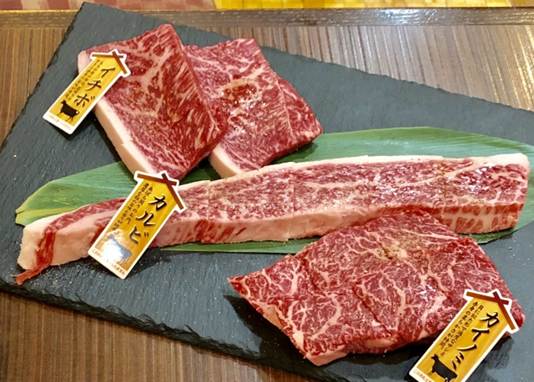
Top left: Ichibo
Ichibo is a rare cut of beef, prized for its great marbling, intense beef flavor, and excellent balance between fat and lean meat. Often used for dishes like beef carpaccio or steak outside of Japan, this top cut is also often served as sashimi when in the Land of the Rising Sun! It’s delicious as a type of yakiniku, too, and is often sliced to a thickness of 0.7cm!
10. Harami (Outer skirt)
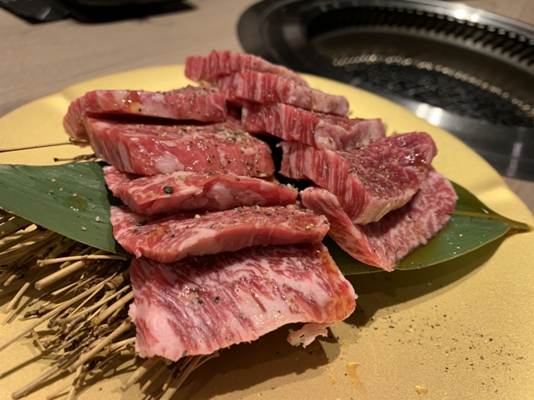
Harami is taken from near the diaphragm of the cow and is a popular choice for yakiniku. It is often served after being marinated in a miso- or soy-based sauce, and as a leaner cut of meat, it has a bold flavor that is brought out when grilled a little longer!
Other Popular Cuts of Beef
Horumon, or cuts of offal, are also a popular kind of yakiniku, especially in the Kansai region of Japan (Kyoto-Osaka-Kobe). Below are two of the most common offal cuts seen in most yakiniku restaurants, but places specializing in horumon would definitely offer a far more extensive selection!
11. Gyu-tan (Beef Tongue)
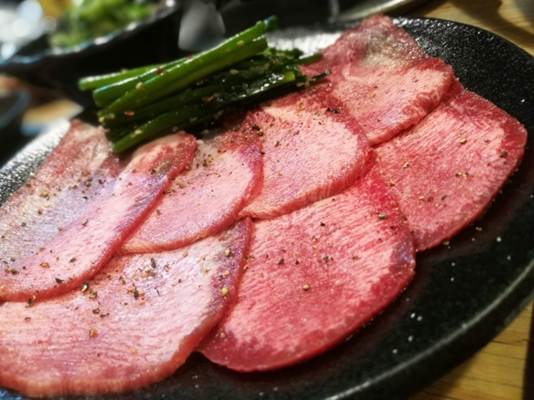
Originating in Sendai, cow tongue is usually seasoned with salt and pepper, and it cooks really quickly as it is sliced thinly! Gyu-tan is sometimes marinated in sesame oil served with negi (chopped green onions), but it is best enjoyed after dipped in lemon juice just before eating!
12. Liver
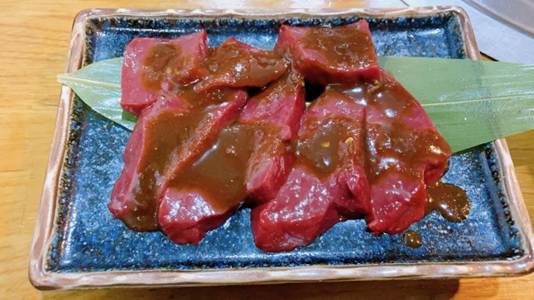
Beef liver marinated in tare
Rich in protein and iron, cow liver is a nutritious cut of meat that’s also high in vitamin A. Most liver in Japan is marinated in tare, a miso and soy-based mixture that counters the bitter and strong iron taste that can sometimes occur in this variety of meat. The end result is sweet, savory, and delicious after grilling!
Enjoying Yakiniku at Restaurants

As yakiniku cuts are often brought to your table raw in Japan, you can cook the meat on your own, so the doneness of each piece can be varied according to your own preferences! Some places in Tokyo might be more “hibachi” style, though, and staff members can cook the meats and vegetables for you.

Enjoy the meats with dipping sauces, salt, and lemon juice – all of which can be found at your table – to see which is your favorite!
Some restaurants also offer tabe-houdai (all-you-can-eat) deals for a flat rate. You start by choosing the course that you want, and the prices vary according to the number of items included in the course. Usually, prices reflect the number of different meat cuts you can try in the course you decide on, and after selecting a given tabe-houdai menu, you can order anything from the set of choices as many times as you want! This just might be the best way to try all the different yakiniku available on your next food tour in Tokyo!
In additional to tabe-houdai deals, there are also often nomi-houdai (all-you-can-drink) sets, which operate along similar lines. For a flat rate, you can order anything on the drink menu as many times as you want, whether its alcoholic or something from the non-alcoholic drinks menu, such as sodas, non-alcoholic beers and virgin cocktails, or juices and teas.
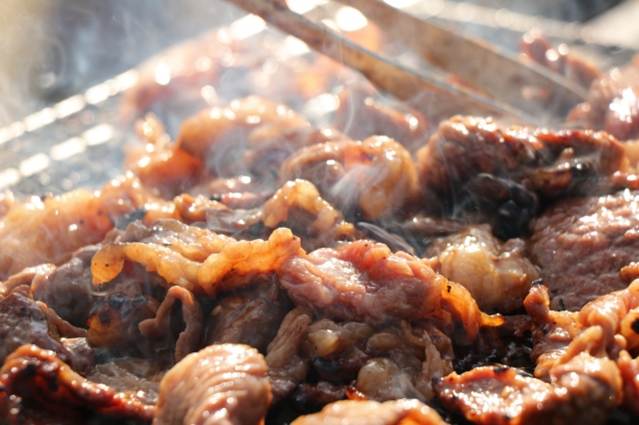
If you’re planning on having yakiniku on your next trip to Tokyo, and would like some help navigating the area, the local tour guides at Best Experience Japan are more than happy to take you out on a one-of-a-kind food tour! Eat like a local at some of the best yakiniku joints in the city and enjoy an exclusive peek into Japan that tastes unlike any other!
